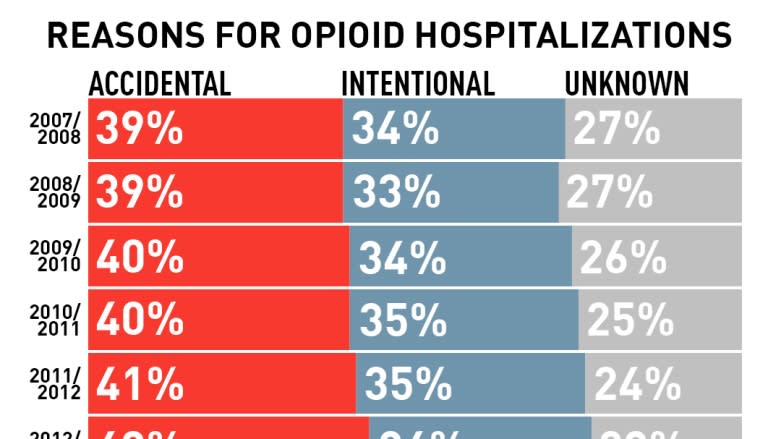Opioid poisonings land 16 Canadians in hospital each day on average, 53% jump over 10 years
The number of Canadians hospitalized because of opioid poisoning is growing dramatically, according to new numbers published by the Canadian Institute for Health Information.
But even with new data, tracking the breadth of the crisis in Canada continues to run up against problems.
Between April 1, 2016 and March 31, 2017, an average of 16 Canadians were hospitalized each day because of opioids, a jump from an average of 13 people every day two years ago.
And more than half of all cases were considered accidental, says CIHI.
The CIHI numbers don't include people who went to an emergency department but were not admitted, or those who died before making it to a hospital.
"We see higher rates of hospitalization in the West and in the North, but while the rates are lower in Eastern Canada they are increasing, and that seems to line up with stories we're hearing about cities starting to encounter opioid-related issues in Eastern Canada," said Brent Diverty, the institute's vice-president of programs.
Diverty said the reason the numbers continue to grow comes down to a few main factors: that opioids are still readily prescribed in large quantities, that people easily become dependent on prescribed opioids and that illegal sources are easily available.
The report shows young people aged 15 to 24 and adults aged 25 to 44 had the fastest growing rates.
Diverty said accidental rates historically were higher among older people, who tend to take more medications.
"This has the potential to be people taking opioids recreationally and not appreciating exactly what they're taking," he said.
Jump in 3 years
While the opioid crisis has been building for several years, the numbers suggest a dramatic recent increase.
"Over the last 10 years, across the country, [we've seen] a 53 per cent increase in hospitalizations for opioid poisonings, but almost half of that increase was in the last three years," he said.
For the first time, CIHI was able to include municipal data that shows cities like Saskatoon, Regina and Victoria had some of the highest rates of hospitalization, exceeding those of larger cities such as Montreal and Toronto.
"I think it's worth giving some thought to why that might be the case. Perhaps there's some unique things going in the population or with prescribing, but it also may be about the availability and accessibility of supports."
A larger problem
Even these new figures show only a portion of the problem.
For example, CIHI only has complete data about emergency department visits due to opioid poisoning from Alberta, where the number of visits doubled, and Ontario, where the number jumped by 40 per cent.
It's also hard to tell how much a role fentanyl is playing.
"In our data, we're not able to explicitly pull out fentanyl as a specific chemical. We can only look at the class which we call synthetic opioids. Some preliminary analysis that we've done suggests that over the last couple of years the number of cases where synthetic opioids were present has doubled from just over six per cent to 12," Diverty said.
Prescribed or illicit opioids?
It's also not clear how many of the hospitalization and emergency room visits were from prescribed opioids or illicit ones.
"It's important when clinicians and those in hospitals are putting down the details of a case in a patient's chart that they're noting the sense of whether opioids were involved in the particular case, because really it's those notes that result in the coded data that we use for this type of thing," he said.
Last winter, during the federal government's opioid summit in Ottawa, CIHI signed a joint statement of action to fill in the gaps in opioid data. It's been working with the provinces and territories, along with their coroners and medical examiners.
Former health minister Jane Philpott promised to address the "huge gaps" in Canada's ability to monitor the crisis.
Updated numbers from the Public Health Agency of Canada shows that there were 2,816 apparent opioid-related deaths in 2016, about eight people a day. There were at least 602 opioid-related deaths in the first quarter of 2017.
The number of deaths involving fentanyl almost doubled between the beginning of 2016 and the beginning of 2017.
"It tells me that we as a government need to do more. We need to work collaboratively with provinces, territories, municipalities, service providers to really get a handle of this situation," said federal Health Minister Ginette Petitpas Taylor during a press conference at a community support agency in Ottawa Thursday.
But even new numbers might not capture the true severity of the problem.
"It's frankly pathetic in terms of understanding use and patterns of use," said Elaine Hyshka, an assistant professor at the School of Public Health at the University of Alberta and co-chair of the commission set up by the Alberta government to tackle the crisis.
Hyshka, who was responding to tracking in general and not CIHI's latest report, said from what researchers know, the crisis is becoming mainstream.
"It's important to know how many people are dying, but they're the tip of the iceberg," she said.
"I think it becomes easier to ignore the problem ... if we don't understand how many people are really touched by this issue and struggling. It's hard to make resource allocations to the degree that's necessary to address the problem and so it undermines arguments for more resources in the response."
For Deirdre Freiheit, president and CEO of the Shepherds of Good Hope shelter in Ottawa, her staff is running up against the rest of that iceberg.
"We've never seen anything like this. We are, our staff is, absolutely fatigued. We would have had a handful of overdoses a year or two ago and now we're seeing multiple overdoses every single day," she said.
"We need help to sustain this pace [of work] ...we need some help."
CBC's The House will have a special show Saturday Sept. 16 about the opioid crisis in Canada.
Tune in at 9 a.m., 9:30 a.m. in Newfoundland.
Or find the episode here.




